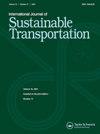建筑环境与机动车辆共享使用的关联:基于车辆的方法
IF 3.1
3区 工程技术
Q2 ENVIRONMENTAL STUDIES
International Journal of Sustainable Transportation
Pub Date : 2025-02-01
DOI:10.1080/15568318.2025.2454693
引用次数: 0
摘要
近年来,共享moped服务在亚洲和欧洲城市变得流行起来,但现有文献提供的影响共享moped使用因素的信息有限。本研究通过生存分析探讨了建筑环境与闲置共享轻便摩托车被租用的概率之间的关系。该研究的观察结果来自台湾台北一位匿名的共享摩托车运营商的全球定位系统记录。实证结果表明:(1)密度和多样性属性与共享助力车使用的关联可以参考其他共享车辆使用,但与普通助力车使用的关联不同。(2)建议共享助力车服务运营商将闲置的共享助力车从就业中心转移到居住、学校或零售活动密集的地区;不同的楼层用途、工业或运输服务;密集的街灯或轻便摩托车停车位。(3)建议共享机动车辆服务运营商根据不同集水区规模和时段的建成环境属性制定车辆再平衡策略。(4)与其他城市公共交通服务相比,共享助动车是一种互补服务,而非竞争服务。本文章由计算机程序翻译,如有差异,请以英文原文为准。
Associations of built environment with moped-sharing use: A vehicle-based approach
In recent years, moped-sharing services have become popular in Asian and European cities, but existing literature provides limited information about factors influencing moped-sharing use. This research explored the associations of built environments with the probabilities that idle shared mopeds become rented through survival analyses. The study observations are from the global positioning system records of an anonymous moped-sharing operator in Taipei, Taiwan. The empirical results indicate the following findings: (1) The associations of density and diversity attributes with moped-sharing use can refer to those of other shared vehicle uses but are dissimilar to those of general mopeds. (2) Moped-sharing service operators are suggested to move idle shared mopeds from employment centers to areas with dense residential, school, or retailing activities; diverse floor uses, industries, or transit services; and dense streetlights or moped parking spaces. (3) Moped-sharing service operators are also suggested to develop vehicle-rebalancing strategies in accordance with the built environment attributes within different catchment area sizes and periods. (4) Moped sharing is a complementary service rather than a competitive service to other intracity public transport services.
求助全文
通过发布文献求助,成功后即可免费获取论文全文。
去求助
来源期刊
CiteScore
8.90
自引率
2.60%
发文量
56
期刊介绍:
The International Journal of Sustainable Transportation provides a discussion forum for the exchange of new and innovative ideas on sustainable transportation research in the context of environmental, economical, social, and engineering aspects, as well as current and future interactions of transportation systems and other urban subsystems. The scope includes the examination of overall sustainability of any transportation system, including its infrastructure, vehicle, operation, and maintenance; the integration of social science disciplines, engineering, and information technology with transportation; the understanding of the comparative aspects of different transportation systems from a global perspective; qualitative and quantitative transportation studies; and case studies, surveys, and expository papers in an international or local context. Equal emphasis is placed on the problems of sustainable transportation that are associated with passenger and freight transportation modes in both industrialized and non-industrialized areas. All submitted manuscripts are subject to initial evaluation by the Editors and, if found suitable for further consideration, to peer review by independent, anonymous expert reviewers. All peer review is single-blind. Submissions are made online via ScholarOne Manuscripts.

 求助内容:
求助内容: 应助结果提醒方式:
应助结果提醒方式:


